Popeye’s 80 Years on Film!
In late 2001 The Popeye Show premiered on The Cartoon Network. This was a half hour anthology series which aired three of the sailor’s films produced by either The Fleischer or Famous Studios. Between the broadcast of the cartoons historical information regarding Popeye’s film career was briefly discussed. My name was listed on the credits of each episode as I helped finance the restoration of the cartoons. Seeing my name on The Popeye Show, for the first time, was a memorable moment in my life.
On July 14, 2013 the spinach-eating sailor celebrates his 80th anniversary as one of the world’s beloved animated cartoon characters.
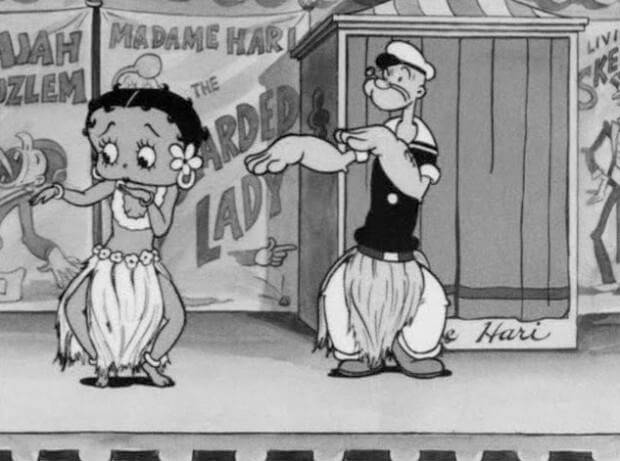
Popeye began his life on January 17, 1929 in the comic strip Thimble Theatre by E.C. Segar. The scrappy sailor was intended for only one story. The newspaper reading public wanted to see more of the character and Segar returned him to the strip. Despite his success in the funny pages Popeye remains best known for his appearances in over 500 animated films which continue to air internationally on television. You can also view the sailor’s films, in various languages on You Tube.
The Fleischer Studios produced animated films with a grittier look depicting the streets of New York. Betty Boop was born from this era and Max Fleischer, who was a big fan of Segar’s strip, plucked Popeye, his girlfriend Olive Oil and the brute, Bluto, from the comic page and into one of Betty’s theatrical cartoons. On July 14, 1933 the comic strip trio appeared in the Betty Boop film, Popeye the Sailor. Betty was seen briefly as the cartoon was designed to see if the sailor could succeed on the movie screen. Popeye passed the test and his own series began three months later.
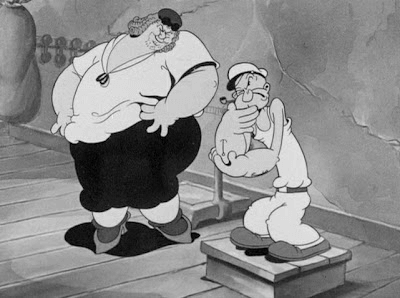
The Fleischer produced Popeye cartoons featured shadows, texture, three dimensional backgrounds and rousing musical scores. They are best remembered for the ad libs provided by the voice actors. William Costello, known as Red Pepper Sam, was the original gruff sounding voice of Popeye. When success went to his head The Fleischers replaced him with in studio artist Jack Mercer. Bonnie Poe, Mae Questel and Margie Hines provided the voice of Olive Oyl. Gus Wickie and Pinto Colvig are best remembered as the voice of Bluto.
Segar’s other fantastic comic strip characters made their animation debuts in the black and white Fleischer films: J. Wellington Wimpy, the hamburger moocher, Swee’pea, Popeye’s adopted son, Eugene the Jeep, the magical creature from the 4th dimension, Poopdeck Pappy, Popeye’s hard to handle father and the monstrous Goons!
In 1936 Popeye starred in the first of three two-reel color films; Popeye the Sailor Meets Sindbad the Sailor. The film earned an Academy award nomination but was beaten by a short from the Walt Disney Studios. However Popeye would get his revenge on Disney when it was announced the sailor’s popularity outdistanced Disney’s Mickey Mouse.
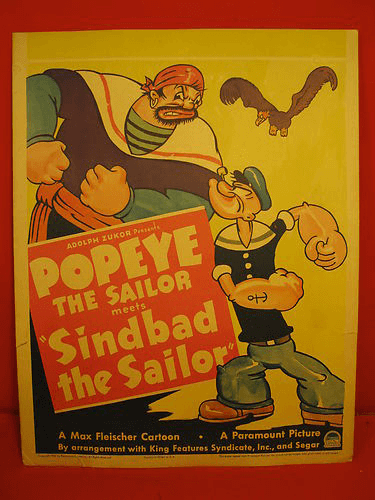
Many tend to think the plots in the sailor man’s series dealt mainly with Popeye and Bluto’s brawling for the affection of Olive Oyl. This was not the case while the cartoons were being produced by The Fleischer Studios. Twist endings, where Popeye did not necessarily end up victorious and Olive Oyl’s fickle nature, were staples of the Fleischer series. As a child I used to scream at the television screen for Popeye to “hurry up” and swallow his spinach for fear Bluto or some other factor would cause him to lose it.
When The Fleischer Studios moved to Florida the Popeye series took on a brighter look but remained Paramount Pictures, who financed the production of the cartoons, number one theatrical property. Popeye and Bluto would change their attire during this period switching to white sailor’s uniforms which reflected U.S. military involvement in the world. Popeye would, for the most part, remain in his Navy whites through the remainder of his theatrical career and made-for-tv cartoons.
By 1942 The Fleischer Studios was deeply in debt to Paramount as their second attempt at a full length animated film, Mr. Bug Goes to Town, failed at the box office. Paramount moved the animation studio back to New York and renamed it Famous Studios. While Popeye’s popularity remained high changes were made in the series. In late 1943 the first color theatrical short was released and Popeye’s look-a-like and sound-a-like nephews became regulars in the series. Olive Oyl was given a bit of a cosmetic makeover. She had a fuller hair style, high heel shoes and visible chest! Jackson Beck became the permanent voice of Bluto. While many of the early Famous Studios films are entertaining, by the early 1950’s, many stories focused on the Popeye-Olive-Bluto romance rivalry.
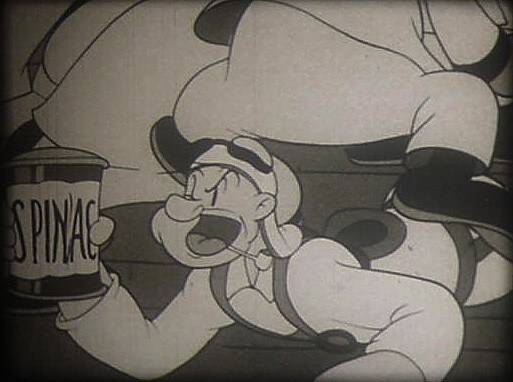
In 1957, Paramount Pictures needed a financial boost and sold the 234 Popeye shorts to Associated Artists Productions for television syndication. To say this sale gave the sailor his second wind would be an understatement. Popeye quickly became the most popular children’s series on the small screen with the cartoons televised all over the country. The swab was the first cartoon character to get star billing on a national basis. A March 20, 1957 advertisement in Variety read: “Spinach rates high with kids when Popeye’s back in town. So does Popeye himself. In 21 cities across the country all markets rated thus far by ARB-Popeye cartoon programs earned a resounding rating of 16.2 on a weekly average, regardless of station, time period or competition.”
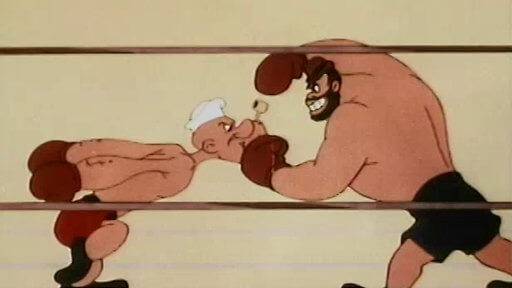
King Features Syndicate, though owning the rights to the Popeye comic strip, did not share in the profits in the syndication of the theatrical films. Al Brodax, head of the syndicate’s television division, hired five animation studios to produce a total of 220 Popeye color cartoons primarily during the years 1960, 1961 with a few remaining in 1962. The personnel involved with these films were Gene Deitch, Larry Harmon, Gerald Ray, Jack Kinney and Seymour Kneitel. Many of the characters from the comic strip, who did not appear in the theatricals, were seen in the television cartoons. These included: King Blozo, Toar, Alice the Goon, Rough House, The Sea Hag and The Whiffle Bird. Due to a dispute over the origins of his name Bluto became known as Brutus! Because of the different personnel involved the quality of the cartoons ranged from poor to excellent. Many prefer the cartoons produced by Paramount Cartoon Studios and under the direction of Seymour Kneitel. That is not to say others are unwatchable but a batch contain animation which is difficult to sit through if you are beyond the age of ten. Jack Mercer, Mae Questel and Jackson Beck provided the voices for the characters that appeared in the cartoons.
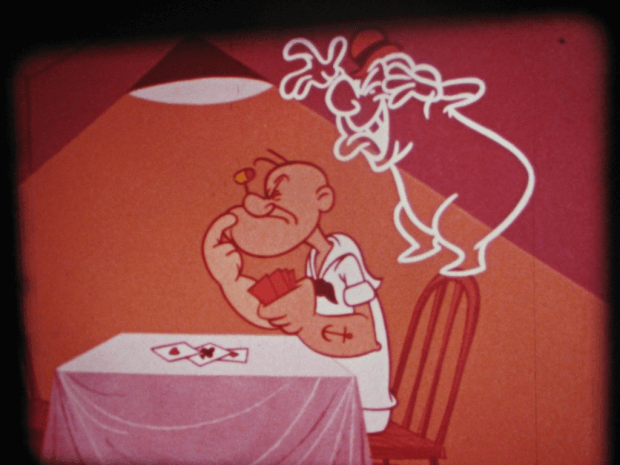
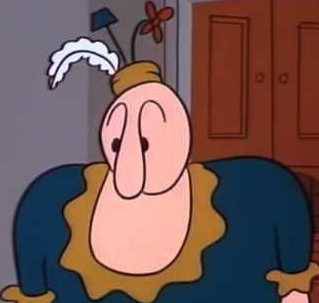
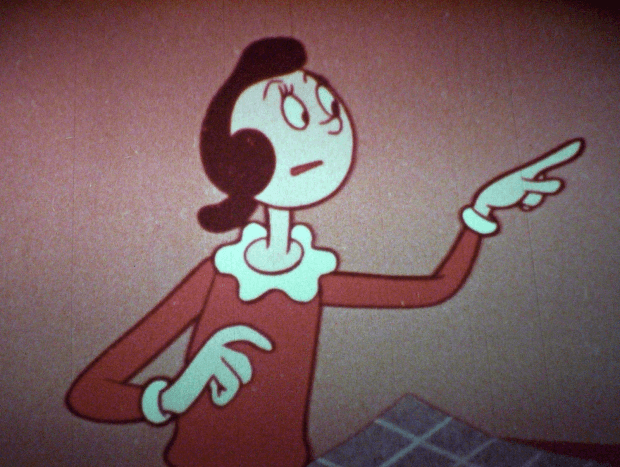
Despite the series’ flaws they were an overwhelming hit on television. The June 10, 1964 edition of Variety ran the headline, “Popeye’s 20,000,000 Gross.” At the time of this article the Fleischer/Famous Popeye films were syndicated to 190 U.S. stations while the television episodes were sold to 125. Many of these outlets played both the theatrical and made-for-tv versions.
By the early 1970’s Popeye’s earnings in newspapers, theatres, and TV had grossed over $50,000.000. In addition to the estimated $100,000,000 in Popeye related merchandise.
In 1972 Popeye, along with several other comic strip characters from King Features Syndicate, appeared in the hour special “The Man Who Hated Laughter”. This program was an episode in The ABC Saturday Superstar Movie. It was directed by Hal Seeger and Jack Zander and aired October 7, 1972.
For the 1978-79 Saturday morning television season Popeye and company returned in The All New Popeye Hour produced by Hanna-Barbera. Despite the fact, due to network guidelines, Popeye could no longer punch Bluto there was a sincere attempt to recapture the era of the Fleischer films. Stories would have unpredictable endings and, except, for retaining his sailor’s hat Popeye wore his original attire from the early Fleischer films. Jack Mercer returned to voice the sailor and wrote several of the stories. Marilyn Schreffler supplied Olive Oyl’s vocals and character actor, Allan Melvin, growled effectively as Bluto. The program originally consisted of two-part treasure part adventures with Olive acting as Popeye’s equal rather than damsel in distress. Health and safety tips were sprinkled though out the hour. The series was so popular it spawned a prime time animated special: The Popeye Valentine’s Day Special-Sweethearts at Sea (1979). In 1981 the series became The Popeye and Olive Comedy Show featuring cartoons with Popeye as a caveman and Olive Oyl in the Army. In 1983 the cartoons from the CBS series entered worldwide syndication.
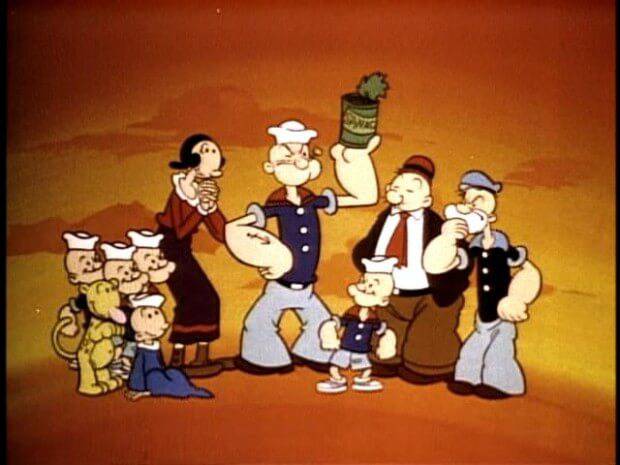
People have said the best thing in the live action feature film, Popeye, was the animated opening featuring the voice of Jack Mercer. Although the film did make money and a sequel was planned it was based on E.C. Segar’s comic strip from the 1930’s. Audiences were unfamiliar with this interpretation of the sailor after years of viewing the animated Popeye.
Hanna-Barbera made another attempt animating Popeye but unfortunately this series focused in the sailor’s son from his marriage to Olive Oyl. Popeye and Son aired on the CBS Saturday morning schedule during the 1987-88 season. The one-eyed sailor’s son was a spinach-hating tyke dubbed “Junior”. The classic characters were modernized with Popeye wearing a loud Hawaiian shirt and Olive donning a gym suit and new hairstyle. Marilyn Schreffler and Allan Melvin returned to perform the voices of Olive Oyl and Bluto while Maurice LeMarche did a passable job as Popeye (Jack Mercer had passed away in 1984). Audiences rejected this updating of the Popeye characters and situations. Despite its one season broadcast the series did air in syndication. It also produced merchandise including several rack toys and a lunchbox.

Several years of faithful reruns followed Popeye and Son until 2004 when Popeye’s Voyage: The Quest for Poopdeck Pappy aired on the Fox Network as a holiday special. This was not an animated version of E.C. Segar’s cast of characters but presented in CGI format. The script was co-written by actor Paul Reisner with the sailor’s voice handled by Billy West. The story, which involved Popeye’s search for his long lost Pappy, was hardly original. This storyline had already unfolded in two theatrical films and one television cartoon. Reviews by fans and critics were mixed with Roger Catlin from Courant TV stating in December 17, 2004, “The bulging biceps and cleft chin turn uncomfortable three-dimensions in the short.” The special was highly rated on Italian television where Popeye’s popularity remains high.
Although the cartoons from King Features and Hanna-Barbera were sold on VHS and DVD for many years this could not be said for the theatrical series. Copyright disputes and legal mismanagement kept them off the market for years. Finally the smoke cleared and in 2007 the first of three DVDs, released by Warner Home Video, featured Popeye’s films from the black and white era. This was followed by a DVD release of cartoons from the Hanna-Barbera series. In 2013 Warner Home Video released many of the best television cartoons, produced by King Features Syndicate, for a DVD release.
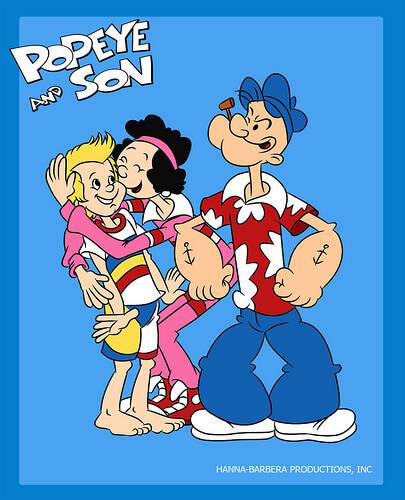
In the works is a Popeye feature film, produced by Sony Pictures, for a 2015 release. Apparently there is still plenty of spinach in the ol’ swabs blood to keep him afloat for the next generation.

